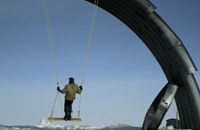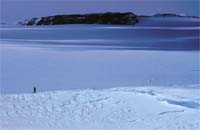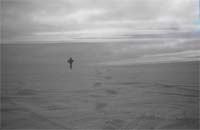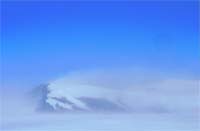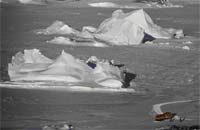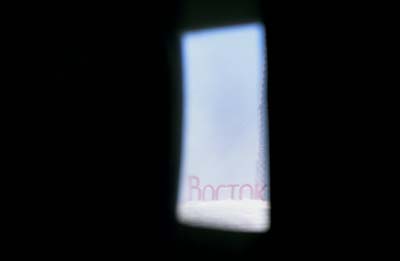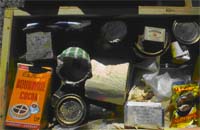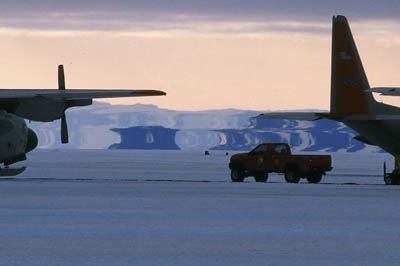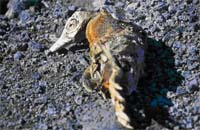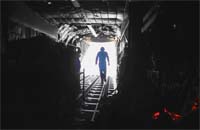Antarctic Aesthetics: some notes

"There was a time when I dared not admit to myself how little refuge and sustenance art finds on this land... Now, what I love in this country is... what constrains any art..."
—Andre Gide, Amyntas
Only Ourselves For Totem
I lean so far into trying to understand this place that I feel encumbered by it, interrogated by it. I've entered a natural history that finds no metaphor in my physical self. Antarctica, in its blankness, demands imaginative personal answers, even begs such questions that insist on self-reflection.
The August halflight on the Transantarctics: the colors of aquarium mix with the colors of fire; tones of orange, raspberry, chrome, lilac and nacre drift like free neon over the subtle radiance of whitened slate.
These color words, however, are shallow. The crepuscular colors of Antarctic August must be imagined as filling the space between the eye and the horizon. The words I use are surface words, but the colors I describe have a depth of being. The air seems lit from within, like bright gas inside a bulb. Light emanates from the snow and ice instead of merely reflecting from it. There is a luster to the ice that the Earth could not predict.
Antarctica is the only major terra incognita ever discovered by Europeans. No native waited on the fast ice as the first wooden ships limped south. No culture predates us. The implications for art are both staggering and unrealized.
There is virtually no middle ground on the ice. The charismatic coastal landscape has a little, as does the denser topography of the nearly ice-drowned Transantarctic Mountains. South Pole, and the 90% of Antarctica that is flat and white, has none.
The rare cases of middle ground on the ice cap are composed by things we import to our campsites: fuel barrels, tents, snowmobile, bamboo poles topped with ragged patches of cloth. Usually, however, we surround ourselves closely with our imports, and beyond them the world leaks out onto the thin bleached line of the horizon.
When I walk away from a camp in the Antarctic interior, it slips suddenly from front yard to distant hamlet.
The Ford Ranges camp crew and I spent the day fossicking and wandering, snowmobiling from one nunatak to another as the mood suited. Nunataks (the peaks of ice-drowned mountains) dotted an otherwise perfect horizon. Small cloud shadows and sunlight dappled the ice cap where it thins toward the continent's edge. Wind blew through the region as if through gravestones.
This West Antarctic still life of nunataks gives us perspective, range, and occasional midground (though not enough to remind us of the world we left behind). The human eye rests on objects that were once mountains, then moves comfortably through the antarctic spaces in between. It's easier to parcel out the great abstraction than to be submerged in it.
On the downslope side of Darling Nunatak, one sheer brown cliff drops a good 700 feet to the ice. At the bottom is a windscoop a hundred feet deep and wide, where venturi-effect winds have swept away accumulating snow for centuries. On the upslope side, where the ice cap ramps directly onto the nunatak, we parked the snowmobiles and went up to hang on the edge of the cliff or forage among stones, sitting among them like the islands of thought that we are.
The stones we pick up are to the hand what these nunataks are to the eye. Islands are points of confluence: the eye, the mind, love them.
"Stretched out, vertical simultaneously outside and inside at the four points of the compass withdrawn yet in the Infinite…"
—Henri Michaux, "Yantra", in Darkness Moves
At the South Pole, we claim to be at the endpoint of a sphere. And it feels that way: the farthest outpost of the familiar, the flat disc of empty space curving away from it, and the overarching perception of extremity that somehow says all routes of departure take us home. We come full circle when we take this singular piece of geography and isolate it with the same imagination we used to create it.
A world of meaning
before meaning.
Still we think
something waits
for someone
the anyone with breath
to thaw silence,
to lay hands on an imagined face.
I'm a mediocre artist. I write small glyphs that rarely sustain narrative or poetic development. My photographs are fine compositions often gutted by poor technique. I make small strange sketches that struggle for pure organic form, in large part because I cannot draw. Everything I write, record, or conjure is hamstrung by a vagueness of purpose.
Mediocrity rarely makes me unhappy. Eight summers of Antarctic work and Antarctic obsession have brought my image-making to a fine pitch of vagueness.
No ravens or wolves moving their dark bodies quietly over the lit plains. No bears roaming the sea ice for fat-rich seals. No men in kayaks slipping around difficult shores in search of penguins.
No hunters borne from these shores. No animals anywhere but on the watery fringe. Antarctica offers no mythic figures from its antibiotic elements. We who have recently arrived have only ourselves for totem.
My friend Kathy, a tall blonde troublemaker who gave up social work to work in Antarctic waste management for a few summers, is angry about the program's wasted lumber. The United States Antarctic Program discards tons of pallets, crates, dunnage, 2" stock and plywood every year, rather than setting it aside for reuse. Each piece of wood has made an epic journey from subsidized American forest to subsidized American outpost. The wood is ground up and shipped back to the U.S. as hog fuel, usually after only a single use.
A recovering Catholic, Kathy's response has been to use the wood to build crosses, memorials to itself. Over one McMurdo summer, she made many small ones, surrounding the wood grinder. At the South Pole the next summer, she planted a forest of larger and larger crosses in the snow, up to twenty feet of beautiful metaphor staring out over the imported American cemetery.
Kathy and I, early in our Antarctic lives, flying low over the pack-ice, faces glued to the LC-130's small portholes, viewing the fragmentation of a jigsaw puzzle larger than most nations. The square-edged polygons of the ice resemble a child's map of the Plains states. "Kansas! Colorado!" I say, pointing.
Amazing what the mind uses to map out its new home. Nebraska becomes what I imagined as a kid: isolated and snowy flatness within black borders. Whales visible among the floes like bison…
"It is not that the land is simply beautiful but that it is powerful. Its power derived from the tension between its obvious beauty and its capacity to take life."
—Barry Lopez, Arctic Dreams
Antarctica confronts us with the inherent threat of a landscape more resilient than life. To be made of flesh, and a consciousness that knows the futility of flesh against this cold, is to be living in the moment of a dream in which beauty and death appear as a single seed. The depth of one's fear determines which of these, beauty or death, we believe contains the other.
I think of where the clean slate of the East Antarctic plateau meets the Transantarctics, where the eye looks inward from the mountains to the great white empty. The landscape's power is beyond the verbal frame of metaphor. "Clean slate" and "great white empty" don't mean a thing. Language fails us. Only an abstraction like "nothingness" takes in the whole view, though that abstraction must also somehow express the transience of our presence.
A statement about the bright field of the Antarctic is also a statement about the passing silhouette of the self.
The land without pentimento. Under our few scratchings and daubs of residence there are no others. A century of exploration and pinpoint occupation put a few swatches of bright color (the colors of come-find-me) in the margins of the continental canvas, a few dots and dashes for our machines' songlines across this yet-unpainted still life, and one small bold period in the center, at the Pole of Perspective.
If silence is the only lingua franca, which I believe, then the ice, holding its tongue (and ours) perfectly, translates all of its would-be colonizers equally on its multilateral and preternatural ground.
I push sentences out toward the horizon, which swallows all but the warmer phrases. Likewise, my landscape photographs are invariably overwhelmed by a sky that presses down upon us like a blue-inked printing press. Hard wind traveling over hard ice translates most thoughts into empty shivering. Aesthetic hypothermia sets up triage on my body of work.
The elements of art are not art themselves. They are both too constrained and too powerful in their expression. Antarctica is a source: it is from elemental platforms like these we go forward to make art, to act upon the cold creation we have witnessed.
"Eternity ticks off the instant with the word."
—Edmond Jabes, The Book Of Questions
When eternity is ticking instants, it is no longer eternity. Words, as Jabes suggests, may be either time or not-time, dislocations outside the ticking.
Words and instants relate similarly to eternity and deep Antarctica: they are parenthetical applications that, if conceived as whole and unfragmented, constrain their "contents" within false limits. The observation these parentheses allow transforms or effectively eliminates that which we measure. Antarctica is composed of identical instants shattered by words. Only by these fragments, however, can we see Antarctica.
No reason to live,
I'm afraid.
Tight as a moon,
one cold seed
binds one blind root
to a hollow sky.
How did it begin,
this bright Pole,
to move my compass?
They Are Not Near Men
"It was the whiteness of the whale that above all things appalled me. But how can I hope to explain myself here; and yet, in some dim, random way, explain myself I must, else all these chapters might be naught…"
—Herbert Melville, Moby Dick
Every contemporary book about the Antarctic has an element of Moby Dick in it. Like Melville's chapters set aside to instruct us on the work of whaling, the narrative experience of journalists or travel writers (the would-be Ishmaels) is always sent home in a ship built from the facts and figures of Antarctic landscape and exploration. Appalling stories of Scott, Shackleton, and other sufferers form one bulwark, and details about the highest driest coldest continent form another. Most Antarctic books do little more than re-explore what has already been written, in part because most authors are afraid that there's nothing else to say. Only residents of the ice grow tired of such repetition. But there's too much unknown, and too little experience of it in public discourse, for even a local writer like me to be able to assume anything. An Antarctic text must carry at least some of this dry cargo of information, so that all the strangeness can be explained for the people back home whose world will never overlap with this one.
"The land is like poetry: it is inexplicably coherent, it is transcendent in its meaning, and it has the power to elevate a consideration of human life."
—Barry Lopez, Arctic Dreams
The Antarctic is like a syllable: it is inexplicably coherent, it offers only fragments of meaning, and it has the power to suggest the absolute reduction of life, and of the poetry of life.
"And this was the thought that the Silence wrought
As it scorched and froze us through,
Though secrets hidden are all forbidden
Till God means man to know,
We might be the men God meant should know
The heart of the barrier snow…"
—Edward Wilson, from "The Barrier Silence"
Characteristic of Robert Falcon Scott's 1912 Terra Nova expedition, the lines speak of romantic visions and a deserved providence. Edward Wilson was a Renaissance man whose work bridged the gaps between science, art and faith. As these lines hint, he served the men of the expedition both as lay-priest and as a relentless source of optimism.
While appreciating that in Wilson's death several months later in the snows of the Ross Ice Shelf (known as the "barrier"), he found the ironic fulfillment of his wish, I still prefer the one verse Ernest Shackleton saved from his Bible when the Endurance was abandoned. God, in this, is a more serious creature. From Job:
"Out of whose womb came the ice?
And the hoary frost of Heaven, who hath gendered it?
The waters are hid as with a stone,
And the face of the deep is frozen."
These are some of the finest Antarctic lines I've read. Shackleton, too, would have understood intimately the frozen face, the stone waters, and the lyric of a man threatened with the absence of both faith and its object.
No answers, but rather a poetry of questions and fear. Meaning is locked away behind the frost wall of Heaven, while ice emerges as both womb and grave.
Around us passages untraceable,
voices of famine unheard.
"Ah, what is the secret you're keeping, to the southward beyond our ken?
This year shall your icy fastness resound with the voices of men?
Shall we learn that you have come from the mountains?
Shall we call you a frozen sea?
Shall we sail to the Northward and leave you, still a secret for ever to be?"
—Ernest Shackleton, in The South Polar Times, August 1902
Poetry, whether written in or about the Antarctic, has rarely if ever made good art. British expeditions went to great lengths to entertain themselves during the long winters, even hand-publishing papers like the South Polar Times, filled with their own poetry and stories. The lines written by explorers either imitated Robert Service's rollicking Klondike tales, or were well-crafted speeches turned to verse, their audience generally being their hut-bound companions. Poems written since the heroic age have rarely escaped the heroic age. Most of them are narrative, derived from history, and lyrical only in their phrasing. The desire for alliance with the romantic terms on which the British explorers met the ice is so strong that there is a long tradition of excerpting that language in new poems, as if such language were the only possible starting point for Antarctic art:
"These precious scraps, culled from sledging journals, memoirs, histories and technical articles are intended simply as lights in a constellation…"
—Donald Finkel, Adequate Earth
Nothing I've found indicates that poetry has been written to embrace the more difficult light of the interior, the albedo of central Antarctica. Such art still waits outside the barrier.
"There are words I need.
They are not near men."
—Charles Simic, from White
In hopes of nurturing south polar poetics, I steal fragments of non-Antarctic literature and graft them onto this lifelessness. The stanzas and lines I import into my book from the outside world will be a bridge, I hope, between the Antarctica that we find in common discourse and the Antarctica that waits just beneath it, beyond our ken.
"White, stacked into distance.
Above it, endless,
the sleigh track of the lost.Below, hidden,
presses up
what so hurts the eyes,
hill upon hill,
invisible."
—Paul Celan, from "Homecoming"
The white stem and black stem.
The white stem and the black stem
interrogates it.
Kathy and I are two of the actors in our friend Nicholas' movie. Plied with whiskey after brunch each Sunday, we put on our insulated Carhartt jackets and his homemade masks and head outside to trudge (me) or prance (her). The Strange and Terrible Fate of Sir Robert Falcon Scott is a 20-minute Dadaist revisioning of Scott's fatal expedition to reach the South Pole.
Three figures, one Scott and two ponies, each signified only by the two-dimensional mask worn deep inside our fur-lined hoods, march in line across the ice, carrying a rock-filled suitcase and journals to record the experience. First one, then the other pony is chased down and symbolically eaten. (Kathy's spirited attempt at escape owed much to her trying to get her blood moving, having forgotten on one Sunday to wear her long johns.) Each pony then becomes a Scott, scribbling by mitten in his journal, adding rocks to the suitcase.
Three Scotts stumble onto the (bamboo) Pole, and begin their wearier stumble home. (I also did a cameo as the blithe Amundsen, jogging across the whiteness dressed in a striped tracksuit.) One by one they drop, as the survivor(s) observe and scribble. As the last Scott lays down his journal and throws an arm over a twin, the wind flips the pages.
It is a silent film, thank god. Too many words sail down to the Antarctic from armchair adventurers to argue the pros and cons of Scott's story. Nicholas filmed out of the silence that fills the icescape. This silence, which was Scott's judge and grave, still has much to say.
"How strange it all seems! For countless ages the great sombre mountains about us have loomed through the gloomy polar night with never an eye to mark their grandeur, and for countless ages the wind-swept snow has drifted over these great deserts with never a footprint to break its white surface; for one brief moment the eternal solitude is broken by a hive of human insects; for one brief moment they settle, eat, sleep, trample, and gaze, then they must be gone, and all must be surrendered again to the desolation of the ages."
—Robert Scott, The Voyage of the Discovery
If Robert Scott's phrasing had been merely average, if his talent for the ringing romantic image had been that of the typical prosaic explorer, then he would never have gained heroic status. The basic narrative of the Terra Nova expedition's plod to their death is very compelling, but no more so than that of the Aurora or Nordenskjold journeys. It's the rhapsodic language of Scott's fragile voice in the wilderness which has sustained his image.
His drama, apotheosized by an anxious Britain, wound up inked irreducibly onto the Antarctic page. It has been the central story - the one we always refer to, as operatic as it is compelling - of our tiny place in human history. (It amazes me that his drama has not yet been written into an opera.)
It's a statement of his abilities that his diary entries from the Terra Nova expedition were often his best writing, though they were essentially first drafts. None of us can live up to the pure romance that those diaries (quietly edited postmortem by his friend J.M. Barrie, the author of Peter Pan) constructed. Scott didn't live up to it either, but it took some time for that to become an acceptable statement.
"We are weak, writing is difficult, but for my own sake I do not regret this journey, which has shown that Englishmen can endure hardships, help one another, and meet death with as great a fortitude as ever in the past."
—Robert Scott, Scott's Last Expedition
For a swan song, Scott used his tentbound final days in March of 1912 to put together letters and final statements that amounted to both a literary and an emotional tour-de-force. The Antarctic is now known generally for what Shackleton did, but is still understood in large part through what Scott wrote.
Scott was a natural portraitist of the Romantic struggle, in which a writer produces either a failed melodrama or a successful mythology. Luckily for Scott, his death "became a parable for the dying British Empire" (Stephen Pyne), and readers embraced the version of Antarctica his ghost had manhauled home.
"He is inhabited by the seriousness of the one Idea. Serious against them all. Certain among them all. Nonetheless, a melancholy, a distress fit for the end of the world, an irreversible fatality inhabit the cold landscape through which he, who is so wrong about himself, is passing."
—Henri Michaux, from "Ravaged People", in Darkness Moves
Sometimes I think of the story of Scott's fatal expedition as the story of language itself voyaging against the silent Antarctic. It took another expedition, the search party, to bring his words home. We are the search party. The writing was better equipped than the man.
"You are now on the continent of the insatiate. At least no one can deprive you, even destitute, of that."
—from Tent Posts
Where was Henri Michaux when Antarctica needed him? Who better to have properly addressed our confusion at the end of the Earth? His exquisite rendering of consciousness would have met the strange erasure of Antarctica perfectly.
His writing life began just before Admiral Byrd first came to the ice in 1928, and continued until a few years after my own arrival in 1994. The unequalled imagination of this demiurgic writer, disturbingly intuitive, should have been applied to this world that is unlike other worlds. Other 20th century writers offer some language that describes similar psychological and antarctic space, but I've found that Michaux's writings consistently make intimate correspondence with the place and our desires within it.
"No, no, the infinite and the forerunner of the infinite is such a relief here that there is nothing, I swear to you, nothing in this world that would make me want to return to yours. We have not forgotten it, you know, cut up in slices, in unequal, surprising slices, a world of distraction..."
—Henri Michaux, "Space Of The Shadows"
If only the beginning of human activity in Antarctica had been accompanied by some literary precedent of non-utility, some art made of inner exploration, something strange and wonderful like Michaux's language, we wouldn't have been stuck with a century of social narrative (expedition diaries and histories, travelogues, and recent accounts by wowed journalists) sailing back from the ice. Ironically, our vision of the reductionist Antarctic has stood harnessed to its 19th century wooden sledge ever since the likes of Mondrian, Schönberg, and Michaux attuned the rest of the world to their difficult increments of consciousness.
This is a land both painfully real and absurdly abstract. There is no native narrative. Moreover, it is a land that offers few poems. It responds better to fragments of poetry that harness the lyric to both prose and silence.
The gap can be best filled with something like Michaux's writing, obsessive and fragmented writing cut from silence, writing of an extremely self-aware imagination. An imagination dispossessed, exiled from everything, and thereby open to anything.
His is the voice that I have heard most clearly reflecting from the Antarctic as I've traveled simultaneously through my books and the ice. His is the language of this interior navigation.
"It is all that is not man around him which makes man human."
—Henri Michaux, Tent Posts
Here we are, full of meat and promise.
"Here a snowstorm is blowing not in the pages of a book but on the other side of the wall."
—Juhan Smuul, Antarctica Ahoy
Smuul, an Estonian Soviet writer, muses on the Antarctic continuum of storm after rereading the final diary entries of Robert Scott's fatal expedition. He is at the Mirnyy base, waiting out a major blizzard himself.
He writes into a book the awe of booklessness this life-threatening storm carries. Should I reread his words when a blizzard overtakes me? And then on my pages I'll send out my own awe to others and their blizzards.
We are all inside the book, someone's book: the storm is always on the other side of the wall. The writer is the storm, and the reader is the book.
Each new book about the ice is an expedition into unfamiliar territory, and will be judged on its merits by those of us who have lived here. Most are ill-fated.
Gossipy Random Essays
The National Science Foundation (NSF), overseer of the USAP (United States Antarctic Program), funds several artists and writers every year in an effort to describe the place to the American public. They were the first, and are the most generous, government entity to do so in the Antarctic.
That said, the NSF won't send any artist or writer to the ice that hasn't promised to provide sufficient publicity. No book contract, significant gallery shows, etc., no grant. The NSF is not interested in art per se as much as they are willing to provide support for art that advertises their operation or shows it in its best light. Art and literature, for the government agency, are business propositions.
Each Artist and Writer Program grantee gratefully receives broad access to our wonders of scenic, scientific, and historic interest. The art produced from these tours is predictably focused on research, wildlife, and history. These are ready-made subjects for which book contracts and gallery shows can be arranged in advance. But the NSF's expectation of a positive spin on their operation, or more generally on the romantic aspects of the Antarctic, will more often lead to children's books than to an expansion of aesthetics. For an agency whose purpose it is to promote knowledge, this is unfortunate.
The American working community (80% of the USAP, about 1200 summer employees) is the single largest social group to experience Antarctica (only the Navy, which no longer inhabits the ice, sent more people), yet is very rarely represented by the work of the NSF's artists and writers. The cooks and mechanics did not pave the way for the grantees to reach the seventh continent, and despite the work we do to sustain the town they reached, we do not often make it onto the page or into the photograph. When we do, we are usually referred to as "researchers".
There are exceptions to the rule, most notably in recent years: Stephen Pyne and Bill Fox as writers, and David Rosenthal and James Barker as visual artists. In his book The Ice, Pyne has single-handedly written the continent into larger aesthetic and intellectual histories, while Fox (in his forthcoming book Terra Antarctica) has detailed how we've imagined Antarctica for the last 2000 years. James Barker came down specifically to photograph people at work. Rosenthal, a painter obsessed with polar twilight, is the only grantee to have started out as an employee.
Nor have many of us begun to make our own art that reaches north of McMurdo. Jim Mastro's photo-illustrated narrative Antarctica: A Year At The Bottom Of The World, published in 2002, was the first Antarctic book put out by an employee. Nicholas Johnson's Big Dead Place, recently released, is the second, and unique in that it focuses exclusively on life in the working community.
Nicholas, Jim, and I have been paid to see the place in unorchestrated fragments as workers and community members. My trash-sorting and aircraft-fueling in McMurdo, and runway-building at remote sites, have provided me a slow tour through what the NSF has artfully convinced America is their exclusive domain.
Of the five non-transient roommates I've had in McMurdo over the years, four make art. Berndt painted obsessively, stacking nudes on canvas and plywood against the wall of our room. Galen quietly contributed centerpieces (an electric chair decked out like a throne, a full-size human figure sculpted out of discarded wires and electronics) to the MAAG (McMurdo Area Art Gallery) shows. Heather sang solo and in two bands. And for two summers, Nicholas and I talked and scribbled, talked and scribbled, as we followed our various Antarctic obsessions through notebooks and cameras.
The MAAG show is an annual station party thoroughly disguised as an urbane and ironic art gallery opening. From do-it-yourself blowtorch ice-sculpting to homegrown surrealist performances, the MAAG gives residents another reason to drink and generally forget about the Antarctic. Very little of the art relates to landscape or "the dialectic between idea and ice" (Stephen Pyne). That said, however, the most beautiful piece I've seen at a MAAG was a simple snapshot of Kelly, a coworker who convinced the remarkable underwater photographer Norbert Wu (a NSF grantee) that she could, on a single breath, submerge herself below the three-meter-thick sea ice long enough for him (in diving gear) to frame and focus his picture. Wu dove deep and positioned himself face-up. Nude, Kelly clung to a weighted rope that took her 12 feet under. Nude, in 28° F water, she let go of the rope and floated under the endless blue skin of the ice.
Nicholas Johnson is the Montaigne, the Raymond Chandler, and the Hunter Thompson of Antarctica. This is a dubious distinction in a land of few authors, but it bears noting. He has single-handedly (in leaflets, zines, his website, and his book) created a literary world for USAP workers, and in doing so has created an ongoing forum for effective satire of life and bureaucracy in the NSF's program.
"Science is a rational approach to existence, and its true practitioners are, for lack of better words, on the right track. However, to unconditionally bestow respect on scientists is like emptying your wallet for each street musician. And to bestow respect on an agency that funds scientists is like giving your wallet to a bus driver with instructions to give it to a street musician."
—from www.bigdeadplace.com
Like Montaigne, who a 19th century anthologist described as "writing gossipy random essays… concealing serious purpose under a mask of careless egotistic trifling; smiling with genial irony at all [the] dogmatism… and fury of the short-lived human ant-hill, touching all parts of life with soothing common-sense, and gently enforcing the moral that 'all is vanity'", Nicholas has cut through pretense in our outpost society with a prose that professes little but offers much. The USAP community is intensely isolated and badly managed, two facts which make rumors, petty tyranny, and muttering dissent all too common.
Like Thompson's, his writing happily wanders through stories of drunken rages and petty tyranny. His gossipy random work strays quietly from tracing the vomit trail of Boozy the Clown to detail a corporate cover-up of asbestos exposure, all the while smiling at the unsurprising humanity. Chandler's L.A. is Nicholas' McMurdo: concise acerbic writing details his experiences within Antarctica's big city. McMurdo is five times larger than the second largest base on the continent, though still just a speck in the vastness of Nicholas' "big dead place". Nonetheless, the beauty and scale of Antarctica receive no more attention than does the endless Pacific that slaps up against the shores of Chandler's Los Angeles.
Of course the Antarctic literary field is wide open. Beyond History and Science, the shelves are nearly empty. Like the local Weddell seals who, with no other voices to confound them in the dark Antarctic waters, sing to each other across the entire acoustic scale, new imaginative writers have the place to themselves.
Sometimes I think of Nicholas as the third literary pioneer in Antarctica's short history, after Robert Scott and Stephen Pyne.
Human Weakness
Antarctic space is all that's left to explore on the planet. Somewhere beyond us are the interiors of invisible things, the blind ocean depths, and the hidden workings of the mind. All these destinations are as much features of the observer's consciousness as they are things in themselves, and are thus antarctic.
"…concepts such as soul and sanity have no more meaning here than gusts of snow; my transience, my insignificance are exalting, terrifying. Snow mountains, more than sea or sky, serve as a mirror to one's own true being, utterly still, utterly clear, a void…"
—Peter Matthiesen, Nine-Headed Dragon River
Ford Ranges: Do the nunataks offer a mirror for the human soul? These beautiful stone outcrops are an immature notion of form in a plane and time that has outstripped form with formlessness. These peaks are both unswallowed and unrevealed. In this respect, they mirror the human presence, our transience.
If these darkened lighthouses are being ground up by the glacial flow of the ice sheet, then who am I, and what good are these faint footsteps and rough breath as I climb a few hundred feet to claim perspective on a landscape of emptiness, dotted with the remnants of what is not yet void? The void keeps me conscious, though it is a consciousness, in its ideal form, which seeks its own demise.
The few lichens here, mere kisses on the stone, contain all life. Yet they are close to nothing, just the suggestion of life. And there is our mirror, exalting, terrifying.
Only when I write do I play with doubting the membership of this hypothermic continent in the flow of life. Out walking, listening, there is no doubt. The silence is alive, deafening. Everything is in motion, albeit imperceptibly, and with such an immense, tectonic pause in its music that I find myself lost in between two notes I may never hear.
Unwilling
To be warmed by a single thought,
Small sharp snow
Makes my bed soft,
Just lay down,
Cold my blanket, ice my pillow.
With horizons as wide as arms,
Arms without a body to hold them.
What's left to think? What wind blows
White teeth across this empty smile?
After three months on the blue-ice glacier: out walking, I find wind-sculpted ice like a woman's hip; ridges of ice shouldering up to impassive ice faces; silk-smooth ice like a remembered neck, and yes, that slope onto which I launch myself, sliding on my parka'd belly with great speed and greater joy, did for a strange moment remind me of the skin of a lover's torso.
Infinitesimal ice crystals fall like the ghosts of punctuation, or sparkle like the lit symbols of mathematics. We who stumble amid the glitter look for ways of making stories out of the ellipses and formulae that are this continent's only blossoms.
Science is attracted to Antarctica, and attractive within it, because the land seems to speak in a mathematical, skeletal idiom. Any data can be read as footprints across the white graph, the jagged narrative like a crevasse across a chart. The Antarctic is baseline, hovering near zero. Temporally, biologically, geographically, atmospherically, we imagine it begging for numbers to fill in where words have never reached. Thus it has been realized as the domestic space program, our local Mars.
The 20th century marked the first elemental forays into the Antarctic empty set, which science has subsumed within its own universe-delineating idiom, with its announcements of first glimpses and elegant discontinuities. We have typed a veneer of digits across the blank page, but the ice is as yet an appendix of absences larger than any book we may write.
We are trashing the Antarctic, of course. Despite my best efforts, wind has ripped plastic from my hands, bamboo from my runway, and petroleum from everything else. Hundred of temporary camps across the continent have left their stain and debris during fifty years of nomadic science. Forests of bamboo poles line now-buried landing zones.
Permanent bases, McMurdo included, have deeply scarred and made toxic their neighborhoods, spewing sewage and chemicals while feeding the dogs with seal and penguin carcasses. Dogs are banned and bases are much cleaner now, but we still assume that some pollution is a small price to pay for good data.
Deep wells of forgotten cargo and sewage travel inside the ice cap toward the coasts. Residuals from roughly five million gallons of burnt diesel fuel sprinkle down every summer from the USAP's intracontinental flights.
Very little of this damage matters, except in the way of aesthetics. We darken and bulldoze in progress-driven exuberance, but there is little to kill. Where we pound snow, we might as well be pounding sand.
The great changes being wrought in the Antarctic are done by the geopolitical entities that have sent us south. Global warming is the hot knife that will slice through the ice shelves and coastal glaciers. Ozone depletion and over-fishing are doing to the bottom of the Southern Ocean's food chain what European whalers and sealers did to the top in the 1800s.
Whether we shit on the snow or delicately hide it under the ice, it's just a drop in the frozen ocean. It's not nice, or intelligent, or particularly advanced for an "advanced" science-based society to pollute our new beds here, but the source of Antarctic transformation is the world, not its outposts.
"I have brought nothing with me of what life requires, so far as I know, but only the universal human weakness."
—Franz Kafka, The Blue Octavo Notebooks
I travel to explore, but to explore not so much a place as the space between the place and me. There are absences (in life, love, and death), and then there's Antarctica. I have no idea which is the better metaphor for the other.
The aesthetic task lies in fulfilling the Antarctic metaphor. The knowledge will come from poetic fragments, if it's possible, and more generally from a greater literature that feeds off the interior. Very little of this admittedly esoteric understanding has been acquired so far, and even less has left the ice to explore the world.
Paul Klee's ink sketch "Human Weakness", dated 1913, shows four figures trapped in allegorical postures against the inside wall of a rough rectangle, which also barely contains a large crude sun. The figures are pinned at the corners of lines that brace the contained whiteness: three men are on their knees, two of them beating at the walls, just below the sun. The fourth man resembles a corpse. The frame resembles the skeleton of a weathered tent.
I've come to think of the sketch as an elegiac window onto the concurrent exploration of the Antarctic, the quest made against this empty solar no-man's-land. It seems also like a 20th century tarot card: the Failed Quest, perhaps?
News of the deaths of Robert Falcon Scott and his party reached Europe by the end of 1912, fodder for the panegyric press and the lyric arts. The explorers' Pole of Ambition became culture's Pole of Tragedy.
We arrive shackled to our northern idea of art evolving out of complexity. Antarctica defines the process whereby art falls out of silence.
Intimacy: How do I say goodbye to a place that never acknowledged my existence? With wonder and ignorance, I suppose, the same brushes I wielded upon arrival.
The true journal of this time made by my shadow as it passed over the ice. In a word, nothing. And I remember it well.
The merriment continues.
What clots under our feet charms the rushing blood.
|
© Copyright Jason Anthony All rights reserved. |


